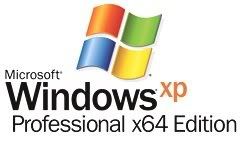64-bit computing....
 If you just bought a new computer or upgraded your existing computer recently and think that you can rest easy knowing that your setup is more or less current, think again. On April 25, Microsoft will be launching Windows XP Professional x64 and Windows Server 2003 x64, signalling the start of the 64-bit consumer era.
If you just bought a new computer or upgraded your existing computer recently and think that you can rest easy knowing that your setup is more or less current, think again. On April 25, Microsoft will be launching Windows XP Professional x64 and Windows Server 2003 x64, signalling the start of the 64-bit consumer era.
The past months have been a flurry of activity for both AMD and Intel, both of which have already introduced 64-bit processors. AMD bolted out of the gate with it's promise of a 64-bit future as early as September 2003, with the introduction of its Opteron and Athlon 64 processor lines. Intel, albeit late in the game, has already introduced 64-bit capabilities to its processors with the recent introduction with the Pentium 4 600 series. Intel also plans to integrate 64-bit capabilities with the rest of Pentium 4 line.
Running at even higher frequencies even with today's most sophisticated lithographic processes has become increasingly difficult, with power consumption and heat dissipation already teetering on the edge of practicality. The solution therefore to the problem of achieving higher processing power is to use two physical processors instead of pushing clock speeds even further. As such, the next battlefield as far as processor design is involved is the mass market introduction of dual-core processors: processors with two processor dies in a single package, working in parallel.
With 64-bit hardware, and soon, a fully 64-bit version of Windows, what can we expect? In a nutshell, simply more speed, and more importantly, more memory.
When we talk of speed, we are not referring to clock speed. We are referring to that actual work done by a CPU in a single processor cycle. 64-bit processors can process data in 64-bit chunks, twice as much as the 32-bit processors that we are currently using.
While 32-bit processors can only recognize up to 4 GB of total memory (physical and virtual, sometimes less, depending on the OS or chipset) 64-bit processors can address much more, theoretically up to 18 exabytes (18 billion GB, 2 raised to the power of 64). AMD's Athlon 64 can address "only" one terabyte (a thousand GB) which is still one to four thousand times more than the memory typically installed in today's typical PC. Windows XP x64, when released, would be able to use only up to 128 GB, still a far cry from our current 4 GB limitation.
With more speed, and more memory, programs and data can be significantly larger than before, leading to more sophisticated programs, larger data sets, and more efficient multitasking.
Already, the introduction of Window XP x64 is being compared to the launch of Windows 95 ten years ago, which ushered in our transition from 16-bit computing to 32 bits. With computing technology growing by huge leaps and bounds, it is a virtual certainty that we would have to bite the bullet and follow suit sooner or later.
By the looks of things, it may even be sooner than we realize.
Comments